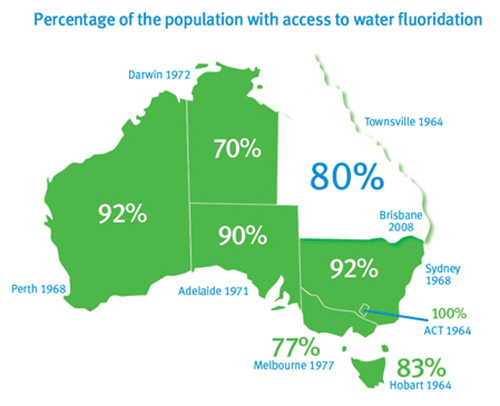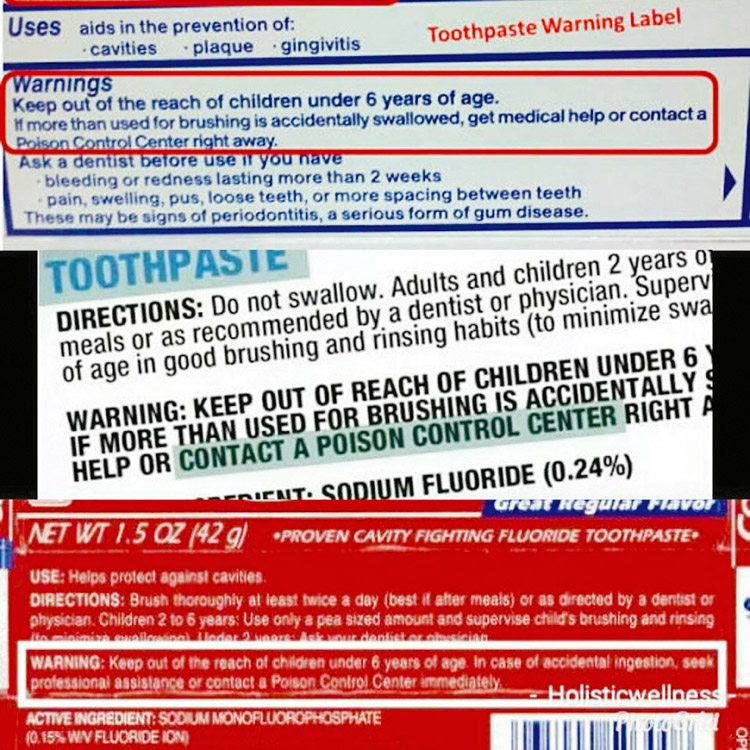From New Dawn Special Issue Vol 14 No 2 (Apr 2020)
Fluoridation amounts to public murder on a grand scale.
– Dr. Dean Burk
More than sixty long years have passed since community water fluoridation began in Beaconsfield, Tasmania. A few decades passed and most of Australia’s water supplies had become fluoridated.
When fluoride was first added to water supplies, asbestos was the preferred fireproofing material, PCBs were used as insulation and in pesticides, and the notoriously “safe and effective” DDT was sprayed in schools and from airplanes over large populations, killing tens of thousands of people from cancer and other diseases. All of these chemicals have been banned, except fluoridation.
The first country to enforce fluoridation was the US that started this practice in 1945 and continues it to this day. Fluoridation is not a common practice, and in 2012 only about 5% of the world consumed fluoridated water. In the US, the Center for Disease Control (CDC) has proclaimed that water fluoridation is “one of public health’s greatest success stories” and “one of 10 great public health achievements of the 20th century.”
Likewise, the Australian Department of Health declared that water fluoridation has been “endorsed by leading organisations in Australia and internationally,” and it has “made a significant contribution to improving the oral health of Australians.” Regarding safety issues, they claim there is “no evidence that water fluoridation at Australian levels is associated with other health effects such as thyroid dysfunction or cancer.” Many government scientists agree with these statements, such as Matthew Hopcraft, Clinical Associate Professor at the Melbourne Dental School. In 2017, he published an article claiming that fluoridation is “one of our greatest public health achievements, with evidence gathered over more than 60 years showing it works and is safe.” He went as far as to state that “making up infant formula with fluoridated tap water at levels found in Australia is safe.”

Australian water supplies contain about 1 ppm of fluoride, i.e. one milligram per litre of water. If we adopt the mainstream reasoning that governments and their scientists serve the interest of the people, then there is no reason to dig any further. However, if we consider tobacco and numerous other hazardous chemicals and practices that at one point were touted to be safe by health authorities, then we should always be highly sceptical of “official truths.” In fact, numerous peer-reviewed studies demonstrate that Australian health authorities have deceived the public about the dangers of fluoridation.
Intelligence
While the CDC and many other organisations praise and glorify water fluoridation on their respective websites and elsewhere, they omit a massive body of peer-reviewed studies that correlate fluoride exposure with reduced IQ in humans. In fact, 64 studies that included a total of 23,773 children and 245 adults have documented this link. Many of these studies examined fluoride levels equivalent to or lower than the concentration found in Australian water supplies and adjusted for relevant variables such as socioeconomic status and toxins that affect IQ.
Mainstream ‘experts’ also omit numerous animal studies that have thoroughly established fluoride can produce cognitive impairment in animals and bring about “anxiety-depression-like behaviours in mice” (Liu et al., 2014). Here are quotations from a small sample of these studies. Bartos and associates concluded in 2019 that “the present study reveals that exposure to [fluoride] in early stages of rat development leads to impairment of memory in young offspring.” Another rat study revealed that “the learning and memory of rats in [the fluoride] group significantly decreased” (Zheng et al., 2016). Jetti et al. showed in their 2016 study that “the rats that received fluoride water exhibited impairment in their spatial learning and memory deficits.” In 2014, a study led by Jiang S. reached the conclusion that “fluoride and arsenic, either alone or combined, can decrease learning and memory ability in rats.” Chioca and co-workers concluded in their 2008 study, which can be found in the European Journal of Pharmacology, that “moderate intoxication with sodium fluoride has potentially deleterious effects on learning and memory.”
Dozens of animal studies have shown adverse cognitive effects in animals as well as many other issues not covered to any degree in this article, including cancer, infertility, loss of bone strength, and genetic damage, each topic requiring lengthy dissertations to cover.
Now we will briefly summarise the conclusions of a few selected epidemiological studies. In 2009, Sudhir and co-workers studied 1,000 schoolchildren exposed to several degrees of fluoride: <0.7 ppm, 0.7-1.2 ppm, 1.3-4.0 ppm, and >4.0 ppm. Sudhir and his research team observed that the “number of intellectually impaired children were gradually increased with the increase in fluoride concentration in the drinking water” and a “high fluoride environment adversely affects the development of intelligence in children.”
Ding and co-workers examined low fluoride levels, between 0.24 and 2.84 ppm, and how they had affected 331 children. They showed that 1 mg of fluoride present in urine was associated with a 0.59-point decrease in IQ. Their study, which was published in 2011 in the Journal of Hazardous Materials, reached the conclusion that “low levels of fluoride exposure in drinking water had negative effects on children’s intelligence and dental health and confirmed the dose-response relationships between urine fluoride and IQ scores as well as dental fluorosis.”
Excessive fluoride intake produces easily seen damage to tooth enamel, called dental fluorosis. In its most severe form, the enamel begins to erode and crumble, often giving the appearance that the teeth are “rotten,” resulting in severe psychological problems, especially among children. Dental fluorosis becomes especially concerning when we consider the CDC’s own study on dental fluorosis in the United States. In the period 1999–2004, the prevalence of dental fluorosis in adolescents, aged 12–15, was 40.6%. For children and adolescents, aged 6-19, a total of 37% had dental fluorosis. A follow-up study by Eman Behbehani that focused on the period 2011-2012 showed that the number of affected had increased to 57% for those aged 6 to 19. Contrary to mainstream experts, fluoridation not only destroys health but also teeth and does so irreversibly. Numerous large-scale studies by independent scientists have demonstrated that populations with unfluoridated water do not have a higher incidence of cavities than in the US and Australia and that fluoridation is ineffective at best.
Urine-fluoride levels are scrupulously (or rather unscrupulously) avoided by mainstream pro-fluoridation scientists in the US and Australia. However, one of the few studies that can be dug up dates back to 1985, named “Urinary fluoride levels in South Australian pre-school children in summer and winter.” It was found that in an area of South Australia (1 ppm of fluoride) the mean urine-fluoride level was 1.72 mg per litre during winter (note that children do not consume as much water as adults). A total of 103 children were excluded from the study as their parents fed them fluoride tablets as recommended by the government. According to the British Fluoridation Society, about 17,600,000 Australians consumed artificially fluoridated water in 2012. By invoking the data from the aforementioned study by Ding, it can be shown that fluoride in Australia is associated with a loss of at least 17.9 million IQ points. As we shall see, this figure underestimates the true nature of the carnage.
In 2019, a major study was published in JAMA Pediatrics titled “Association Between Maternal Fluoride Exposure During Pregnancy and IQ Scores in Offspring in Canada.” This study, which had been funded by the US National Institute of Environmental Health Science and by the Canadian government, demonstrated that an increase of 1 mg of fluoride in urine among pregnant women resulted in a 4.5-point decrease in IQ among boys, and collectively for both genders a drop of 3.66 IQ-points could be documented.
It gets much worse. The US government approved and secretly installed “fluoridators” in schools across the US in the 1960s, and possibly earlier, and continued until the 1990s to adjust fluoride levels to as high as 5.4 ppm. In 1992, over 100,000 school children were exposed to this horror. Dr Philippe Grandjean of the Harvard School of Public Health, who has published several papers on fluoride, stated in 2014 that “fluoride seems to fit in with lead, mercury, and other poisons that cause chemical brain drain.”
In a presentation on fluoride, renowned neurosurgeon Dr Russell Blaylock asked: “If you’ve demonstrated [that fluoridation] doesn’t reach its objective: that is reducing cavities… Why is it still being added to the water? If it has these profound health effects, why is it still being added to the water?… Either they’re incredibly stupid and incompetent or criminal or they are doing it on purpose.”
Other Health Effects
This article has briefly examined a few selected studies revealing that fluoride affects IQ, but the problem does not end there. Fluoride causes havoc in the body. Fluoridation can damage the male reproductive system (see, for example, Freni et al., 1994), and studies from China, India, Mexico, and Russia show that high fluoride exposure can reduce male testosterone levels (see, for example, Peizhong et al., 1997). Those who live in fluoridated areas are well-advised to filter all of their water (even that which is used for showering). Inexpensive water filters removing fluoride are easily accessible (e.g. ZeroWater). Toothpaste without fluoride is readily available in health stores and online.
Dr Dean Burk, one of the most famous and decorated cancer research scientists in the world during the 20th century, and Dr John Yiamouyiannis, president of the Safe Water Foundation, compared in a 1975 epidemiological survey the cancer mortality rate of central cities in the United States that were either fluoridated or unfluoridated. Prior to fluoridation, the cancer death rate remained identical for both sets of cities, but subsequent to fluoridation the cancer death rate skyrocketed in the fluoridated cities, but not in the unfluoridated ones. In 1976, Dr Burk was asked: “Is this conclusive evidence that fluoride kills because of cancer?” He replied as follows: “It is one of the most conclusive bits of scientific and biological evidence that I have come across in my 50 years in the field of cancer research.” He added, “[fluoridation] amounts to public murder on a grand scale.”
The explosive findings were a thorn in the side of the pro-fluoridation policy of the US government, and the study was criticised, the main contention being that the association could be explained away by demographic changes. In 1977, Burk and Yiamouyiannis addressed the criticism in another survey. They showed that sex, race, and age did not explain the significant cancer deaths correlated to fluoride.
The cancer-fluoride survey led to three historic trials in Pennsylvania, Illinois, and Texas in 1978-1982. Although pro-fluoridation scientists from the National Cancer Institute, the National Academy of Sciences, the Royal Statistical Society, and the Royal College of Physicians attempted to dispute the evidence, three veteran trial judges in three different States found that water fluoridation causes cancer and other ailments in humans. In each of the trials, it had been shown that the US government, or their surrogates, had attempted to conceal laboratory studies showing that fluoride causes cancer, and left out available and pertinent data in their demographic adjustment of surveys linking fluoridation and human cancer (Graham et al., 1999). These findings were never disturbed on appeal.
After the judicial findings, Dr Burk and co-workers published more expansive adjustments of demographic factors in epidemiological data in 1984 and 1988, showing that the evidence presented in court was too conservative. Specifically, Burk, Graham, and Morin showed in 1988 that “artificial fluoridation appears to cause or induce about 20-30 excess cancer deaths for every 100,000 persons exposed per year after about 15-20 years.” Using this data, it can easily be shown that at least a million excess cancer deaths in the United States have been caused or promoted by water fluoridation since this measure was endorsed by the government of the United States in 1951.
Fluoride also affects behaviour. Following extensive peer-review in 1995, Mullenix and co-workers published their study into the possible neurotoxicity of fluoride in rats. In order to eliminate bias, Mullenix utilised a computer-pattern-recognition-system to detect if fluoride had an effect on behaviour. Strikingly, it was discovered that fluoride produced life-long changes in behaviour. If young rats were exposed to fluoride in their drinking water for a few weeks of the rat’s lifetime, it produced hypoactivity. Mullenix later said, “they became slower, ‘couch potatoes’ if you like.” They also gave a one-time subcutaneous injection of fluoride into pregnant rats. As the offspring of those rats grew up, they became distinctly hyperactive, indicating that fluoride affects different regions of the brain depending on the time exposure. Mullenix and her team also discovered that “there was major accumulations of fluoride in all the regions of the brain, and that some areas looked like there were greater accumulations than others, that were sex-determinant.”
Several other animal and epidemiological studies have supported the conclusions drawn by Mullenix, including Jennifer Anne Luke’s PhD dissertation in 1997 which showed that fluoride accumulates in the pineal gland affecting melatonin production and results in accelerated onset of sexual maturation in female gerbils. In regard to hyperactivity, a 2015 study demonstrated that “state prevalence of artificial water fluoridation in 1992 significantly positively predicted state prevalence of ADHD in 2003, 2007 and 2011, even after controlling for socioeconomic status…. Each 1% increase in artificial fluoridation prevalence in 1992 was associated with approximately 67,000 to 131,000 additional ADHD diagnoses from 2003 to 2011” (Malin et al., 2015).
Pursuant to Dr Blaylock, the effects of fluoridation and other environmental toxins are immense: “We’re seeing a society that not only has a lot more people of lower IQ, but a lot fewer people of higher IQ. In other words: a dumbing down, a chemical dumbing down of society. So everyone is sort of mediocre. That leaves them dependent on government, because they can’t excel. We have these people of lower IQ who are totally dependent. Then we have this mass of people who are going to believe anything they are told because they can’t really think clearly – and very few people of a very high IQ have good cognitive function who can figure this all out. And that’s what they want.”
Successive government officials, academics, mainstream experts, dentists, and journalists continue to cover-up fluoridation’s profoundly hazardous effects. The responsible parties must be hurled before the International Criminal Court for crimes against humanity.
© New Dawn Magazine and the respective author.
For our reproduction notice, click here.






